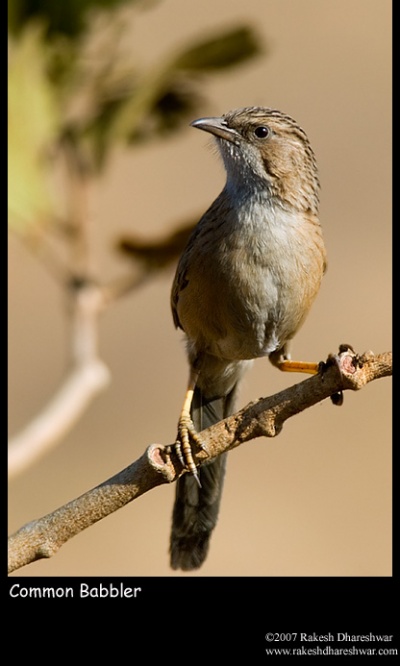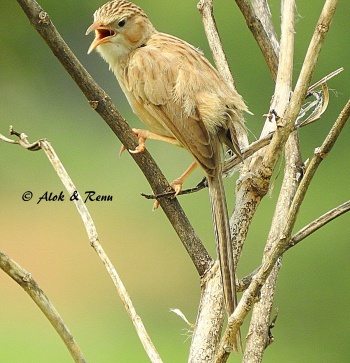Aloktewari (talk | contribs) (Image 1 caption imp. / Image showing dorsal view added.) |
(Imp sizes. Basic tidy-up. References updated) |
||
| Line 1: | Line 1: | ||
| − | [[Image:Common_Babblera.jpg|thumb| | + | [[Image:Common_Babblera.jpg|thumb|400px|right|Ventral view<br />Photo by {{user|Rakesh|Rakesh}}<br />Diwe Ghat, Pune [[India]], February 2007]] |
;[[:Category:Turdoides|Turdoides]] caudata | ;[[:Category:Turdoides|Turdoides]] caudata | ||
==Identification== | ==Identification== | ||
| − | + | 20-26 cm (7¾-10¼ in) | |
* Very long-tailed Babbler | * Very long-tailed Babbler | ||
| − | * Slender, slightly | + | * Slender, slightly down-curved bill |
* Dark eyes | * Dark eyes | ||
* Strong dark streaks on pale buff to grey upperparts | * Strong dark streaks on pale buff to grey upperparts | ||
* Unmarked pale underparts | * Unmarked pale underparts | ||
====Confusion species==== | ====Confusion species==== | ||
| − | |||
[[Spiny Babbler]] in Nepal is darker above and paler below. [[Striated Babbler]] in northern India and Pakistan has a dark throat. | [[Spiny Babbler]] in Nepal is darker above and paler below. [[Striated Babbler]] in northern India and Pakistan has a dark throat. | ||
==Distribution== | ==Distribution== | ||
| Line 15: | Line 14: | ||
Resident. | Resident. | ||
==Taxonomy== | ==Taxonomy== | ||
| − | Two subspecies accepted: | + | ====Subspecies==== |
| + | [[Image:common_babbler_alok.JPG|thumb|350px|right|Dorsal view<br />Photo by {{user|aloktewari|Alok Tewari}}<br />Sultanpur, Gurgaon, Haryana, [[India]], August 2015]] | ||
| + | Two subspecies accepted<sup>[[#References|[3]]]</sup>: | ||
* ''T. c. caudata'' in [[Pakistan]], most of [[India]], [[Nepal]] and [[Bangladesh]] | * ''T. c. caudata'' in [[Pakistan]], most of [[India]], [[Nepal]] and [[Bangladesh]] | ||
* ''T. c. eclipes'' in northern [[Pakistan]] and adjacent [[India]] | * ''T. c. eclipes'' in northern [[Pakistan]] and adjacent [[India]] | ||
| Line 23: | Line 24: | ||
Dry open scrubland, semi-deserts, thorn-scrub, sandy floodplains and rocky hills. | Dry open scrubland, semi-deserts, thorn-scrub, sandy floodplains and rocky hills. | ||
==Behaviour== | ==Behaviour== | ||
| − | Feeds mainly on insects but takes also grains, berries and nectar. Forages in noisy groups of 6 - 7 birds (called Seven Sisters in India, a name which is also used for Yellow-billed Babbler) but groups can be bigger. | + | ====Diet==== |
| + | Feeds mainly on insects but takes also grains, berries and nectar. Forages in noisy groups of 6 - 7 birds (called Seven Sisters in India, a name which is also used for Yellow-billed Babbler) but groups can be bigger. | ||
| + | ====Breeding==== | ||
Breeding season all year. May breed several times a year. Co-operative breeder with complex family structures. The nest is a neat, deep cup, made of grasses and placed in a bush or a small tree. Lays 3 - 5 eggs. | Breeding season all year. May breed several times a year. Co-operative breeder with complex family structures. The nest is a neat, deep cup, made of grasses and placed in a bush or a small tree. Lays 3 - 5 eggs. | ||
==References== | ==References== | ||
| − | #{{Ref-HBWVol12}}#{{Ref-RasmussenAnderton05}} | + | #{{Ref-HBWVol12}}#{{Ref-RasmussenAnderton05}}#{{Ref-Clements6thAug16}} |
{{ref}} | {{ref}} | ||
==External Links== | ==External Links== | ||
Revision as of 01:37, 22 January 2017
- Turdoides caudata
Identification
20-26 cm (7¾-10¼ in)
- Very long-tailed Babbler
- Slender, slightly down-curved bill
- Dark eyes
- Strong dark streaks on pale buff to grey upperparts
- Unmarked pale underparts
Confusion species
Spiny Babbler in Nepal is darker above and paler below. Striated Babbler in northern India and Pakistan has a dark throat.
Distribution
Found in South Asia: From southern Pakistan to India, Nepal and Bangladesh.
Resident.
Taxonomy
Subspecies
Two subspecies accepted[3]:
- T. c. caudata in Pakistan, most of India, Nepal and Bangladesh
- T. c. eclipes in northern Pakistan and adjacent India
Afghan Babbler was formerly considered conspecific.
This species is also sometimes placed in genus Argya.
Habitat
Dry open scrubland, semi-deserts, thorn-scrub, sandy floodplains and rocky hills.
Behaviour
Diet
Feeds mainly on insects but takes also grains, berries and nectar. Forages in noisy groups of 6 - 7 birds (called Seven Sisters in India, a name which is also used for Yellow-billed Babbler) but groups can be bigger.
Breeding
Breeding season all year. May breed several times a year. Co-operative breeder with complex family structures. The nest is a neat, deep cup, made of grasses and placed in a bush or a small tree. Lays 3 - 5 eggs.
References
- Del Hoyo, J, A Elliott, and D Christie, eds. 2007. Handbook of the Birds of the World. Volume 12: Picathartes to Tits and Chickadees. Barcelona: Lynx Edicions. ISBN 978-8496553422
- Rasmussen, PC and JC Anderton. 2005. Birds of South Asia: The Ripley Guide. Barcelona: Lynx Edicions. ISBN 978-8487334672
- Clements, J. F., T. S. Schulenberg, M. J. Iliff, D. Roberson, T. A. Fredericks, B. L. Sullivan, and C. L. Wood. 2016. The eBird/Clements checklist of birds of the world: v2016, with updates to August 2016. Downloaded from http://www.birds.cornell.edu/clementschecklist/download/
Recommended Citation
- BirdForum Opus contributors. (2024) Common Babbler. In: BirdForum, the forum for wild birds and birding. Retrieved 20 April 2024 from https://www.birdforum.net/opus/Common_Babbler
External Links





